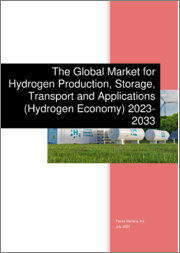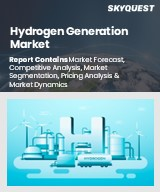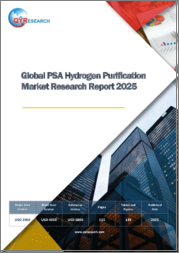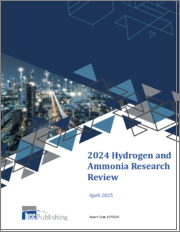
|
시장보고서
상품코드
1305292
세계의 수소 제조, 저장, 운송 및 응용 시장(수소 경제) 2023-2033년The Global Market for Hydrogen Production, Storage, Transport and Applications (Hydrogen Economy) 2023-2033 |
||||||
수소 수요는 몇 년 안에 1조 달러 규모의 시장이 될 것으로 예상됩니다.
세계 수소 제조, 저장, 운송, 응용 시장에 대해 조사했으며, 시장 개요와 함께 부문별 동향, 시장 진입 기업 개요 등을 정리하여 전해드립니다.
목차
제1장 조사 방법
제2장 서론
- 수소 분류
- 세계의 에너지 수요와 소비
- 수소 경제와 제조
- 수소 제조별 CO2 배출 절감
- 수소 밸류체인
- 국가의 수소에 대한 대처
- 시장 과제
제3장 수소 시장 분석
- 업계 발전 : 2020-2023년
- 시장 맵
- 세계의 수소 제조
- 산업 용도
- 수소에너지
- 현재의 연간 수소 제조량
- 수소 제조 공정
- 제조 비용
- 세계의 수소 수요 예측
- 그린 수소
- 에너지 전환의 역할
- SWOT 분석
- 전해조 기술
- 시장 관계자
- 블루 수소(저탄소 수소)
- 그린 수소에 대한 이점
- SWOT 분석
- 제조 기술
- 탄소 포집
- 시장 관계자
- 수소 저장과 수송
- 시장 개요
- 수소 수송 방법
- 수소 압축, 액화, 저장
- 시장 관계자
- 수소 이용
- 수소 연료전지
- 대체 연료 제조
- 수소 자동차
- 항공
- 암모니아 생성
- 메탄올 제조
- 제강
- 전력과 열 발생
- 해사
- 연료전지 열차
제4장 기업 개요(244사 기업 개요)
제5장 참고문헌
ksm 23.07.24The Global Market for Hydrogen Production, Storage, Transport and Applications (Hydrogen Economy) 2023-2033 is an essential resource for anyone involved in the hydrogen, energy and sustainability industries. Hydrogen technology and production is a key part of decarbonization strategies and a means to achieve direct electrification. The report provides extensive proprietary data on green and blue hydrogen production and capacity, trade, demand, applications, market share, and pricing. Hydrogen demand is potentially a trillion dollar market within a few years.
The publication covers all elements of this fast-growing market. Future market development and low-carbon innovation is driven by new green hydrogen (electrolyzers) and blue hydrogen technologies as there is a significant market need to develop new low-cost and low-carbon technologies for hydrogen production.
Other important elements include:
- storing and transporting hydrogen.
- hydrogen fuel cells.
- hydrogen vehicles including taxis, planes and cars.
- alternative fuels.
- ammonia production.
- methanol production.
- steelmaking.
- power & heat generation.
- marine/maritime.
- fuel cell trains.
Report contents include:
- Analysis of current hydrogen production (grey, brown etc.) and demand forecasts to 2033.
- Market value chain and industry map.
- Market drivers, trends and challenges.
- Hydrogen production processes and costs.
- Recent industry developments and investments and start-up funding.
- Market analysis of hydrogen technology and production including blue hydrogen (from decarbonised natural gas), green hydrogen (from renewable power and electrolysis), carbon capture, hydrogen storage & transport, hydrogen fuel cells, hydrogen vehicles, alternative fuels, ammonia production, methanol production, steelmaking, power & heat generation, marine, and fuel cell trains.
- Profiles of 244 companies including large corporations and start-ups. Companies profiled include Advanced Ionics, Aker Horizons, C-Zero, Dynelectro, Ekona Power, Electric Hydrogen, Enapter, EvoIOH, FuelCell Energy, Heliogen, HiiROC, Hystar, HydrogenPro, Innova Hydrogen, Ionomr Innovations, ITM Power, Jolt Electrodes, McPhy Energy SAS, Monolith Materials, NEL Hydrogen, Ohmium, Plug Power, PowerCell Sweden, Sunfire, Syzgy Plasmonics, Thiozen, Thyssenkrupp Nucera and Verdagy.
TABLE OF CONTENTS
1. RESEARCH METHODOLOGY
2. INTRODUCTION
- 2.1. Hydrogen classification
- 2.2. Global energy demand and consumption
- 2.3. The hydrogen economy and production
- 2.4. Removing CO2 emissions from hydrogen production
- 2.5. Hydrogen value chain
- 2.5.1. Production
- 2.5.2. Transport and storage
- 2.5.3. Utilization
- 2.6. National hydrogen initiatives
- 2.7. Market challenges
3. HYDROGEN MARKET ANALYSIS
- 3.1. Industry developments 2020-2023
- 3.2. Market map
- 3.3. Global hydrogen production
- 3.3.1. Industrial applications
- 3.3.2. Hydrogen energy
- 3.3.2.1. Stationary use
- 3.3.2.2. Hydrogen for mobility
- 3.3.3. Current Annual H2 Production
- 3.3.4. Hydrogen production processes
- 3.3.4.1. Hydrogen as by-product
- 3.3.4.2. Reforming
- 3.3.4.3. Reforming or coal gasification with CO2 capture and storage
- 3.3.4.4. Steam reforming of biomethane
- 3.3.4.5. Water electrolysis
- 3.3.4.6. The "Power-to-Gas" concept
- 3.3.4.7. Fuel cell stack
- 3.3.4.8. Electrolysers
- 3.3.4.9. Other
- 3.3.5. Production costs
- 3.3.6. Global hydrogen demand forecasts
- 3.4. Green hydrogen
- 3.4.1. Role in energy transition
- 3.4.2. SWOT analysis
- 3.4.3. Electrolyzer technologies
- 3.4.3.1. Alkaline water electrolysis (AWE)
- 3.4.3.2. Anion exchange membrane (AEM) water electrolysis
- 3.4.3.3. PEM water electrolysis
- 3.4.3.4. Solid oxide water electrolysis
- 3.4.4. Market players
- 3.5. Blue hydrogen (low-carbon hydrogen)
- 3.5.1. Advantages over green hydrogen
- 3.5.2. SWOT analysis
- 3.5.3. Production technologies
- 3.5.3.1. Steam-methane reforming (SMR)
- 3.5.3.2. Autothermal reforming (ATR)
- 3.5.3.3. Partial oxidation (POX)
- 3.5.3.4. Sorption Enhanced Steam Methane Reforming (SE-SMR)
- 3.5.3.5. Methane pyrolysis (Turquoise hydrogen)
- 3.5.3.6. Coal gasification
- 3.5.3.7. Advanced autothermal gasification (AATG)
- 3.5.3.8. Biomass processes
- 3.5.3.9. Microwave technologies
- 3.5.3.10. Dry reforming
- 3.5.3.11. Plasma Reforming
- 3.5.3.12. Solar SMR
- 3.5.3.13. Tri-Reforming of Methane
- 3.5.3.14. Membrane-assisted reforming
- 3.5.3.15. Catalytic partial oxidation (CPOX)
- 3.5.3.16. Chemical looping combustion (CLC)
- 3.5.4. Carbon capture
- 3.5.4.1. Pre-Combustion vs. Post-Combustion carbon capture
- 3.5.4.2. What is CCUS?
- 3.5.4.3. Carbon Utilization
- 3.5.4.4. Carbon storage
- 3.5.4.5. Transporting CO2
- 3.5.4.6. Costs
- 3.5.4.7. Market map
- 3.5.4.8. Point-source carbon capture for blue hydrogen
- 3.5.4.9. Carbon utilization
- 3.5.5. Market players
- 3.6. Hydrogen Storage and Transport
- 3.6.1. Market overview
- 3.6.2. Hydrogen transport methods
- 3.6.2.1. Pipeline transportation
- 3.6.2.2. Road or rail transport
- 3.6.2.3. Maritime transportation
- 3.6.2.4. On-board-vehicle transport
- 3.6.3. Hydrogen compression, liquefaction, storage
- 3.6.3.1. Solid storage
- 3.6.3.2. Liquid storage on support
- 3.6.3.3. Underground storage
- 3.6.4. Market players
- 3.7. Hydrogen utilization
- 3.7.1. Hydrogen Fuel Cells
- 3.7.1.1. Market overview
- 3.7.2. Alternative fuel production
- 3.7.2.1. Solid Biofuels
- 3.7.2.2. Liquid Biofuels
- 3.7.2.3. Gaseous Biofuels
- 3.7.2.4. Conventional Biofuels
- 3.7.2.5. Advanced Biofuels
- 3.7.2.6. Feedstocks
- 3.7.2.7. Production of biodiesel and other biofuels
- 3.7.2.8. Renewable diesel
- 3.7.2.9. Biojet and sustainable aviation fuel (SAF)
- 3.7.2.10. Electrofuels (E-fuels, power-to-gas/liquids/fuels)
- 3.7.3. Hydrogen Vehicles
- 3.7.3.1. Market overview
- 3.7.4. Aviation
- 3.7.4.1. Market overview
- 3.7.5. Ammonia production
- 3.7.5.1. Market overview
- 3.7.5.2. Decarbonisation of ammonia production
- 3.7.5.3. Green ammonia synthesis methods
- 3.7.5.4. Blue ammonia
- 3.7.5.5. Chemical energy storage
- 3.7.6. Methanol production
- 3.7.6.1. Market overview
- 3.7.6.2. Methanol-to gasoline technology
- 3.7.7. Steelmaking
- 3.7.7.1. Market overview
- 3.7.8. Power & heat generation
- 3.7.8.1. Market overview
- 3.7.9. Maritime
- 3.7.9.1. Market overview
- 3.7.10. Fuel cell trains
- 3.7.10.1. Market overview
- 3.7.1. Hydrogen Fuel Cells



















